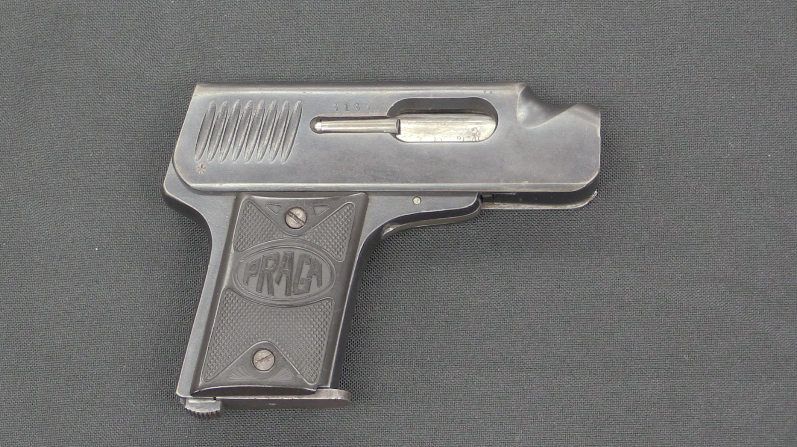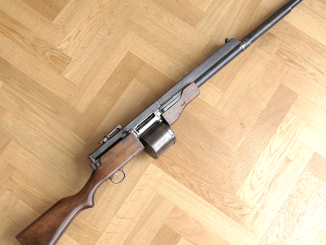This CZ Model S rifle is one of many prototypes made between the world wars in Czechoslovakia in an effort to develop a military semiautomatic rifle. Similar efforts were underway in most other countries at the same time (basically every place that had a mature arms industry), and a huge variety of ideas were tried out.
In this case, we have a gas operated, tilting bolt rifle design. It is chambered for the 8×57 Mauser cartridge, and uses a 10-round detachable magazine. This rifle has a 1929 acceptance mark, which dates it nicely for us. It was designed by a team including one of the Holek brothers, and did better than its competition in trials – but not well enough to be accepted by the Czech military or to attract any outside commercial interest. Holek would go on to design the ZH-29 rifle, and CZ would move on to a series of other designs that ultimately led to naught.




Beautifully made- typical of CZ. if I had the money, I would try to acquire just as a piece of machinists’ artwork.
This looks to me as a potentially better design that post-war Vz.52; definitely in recoil spring management area. Pretty well everything has ingenious touches on it; strange it did not get implemented or returned to in post WWII period.
I have to command Ian for his excellent effort of Czech name pronunciations. It’s almost perfect.
A very impressive design with some well thought out features. Any idea what the problems were that stopped it from being developed further? It looks like it should have had great potential.
Watching year: 1929, I would bet that:
https://en.wikipedia.org/wiki/Wall_Street_Crash_of_1929
ARGH! I’m beginning to wish I could afford to own such a beauty! If the Model S had been made in such a manner that it could be mass-produced at a reasonable price, perhaps a private military company in some fictional universe (like the one I’m typing into existence at this moment) could procure a production batch as designated marksman’s rifles. Simple disassembly would help with those without access to specialized tools. No need to fear a Garand thumb because of the detachable magazine (and had this been developed with interchangeable magazines, there’d be no need to fiddle with clips until you returned to base).
Any ideas for possible improvements?
For a DMR, milling a scope base mount into the left side of the receiver, as on the K43, would be the obvious thing. A detachable, folding bipod that hooked on to the lower front sling mount would be handy, too.
Threading the muzzle for a suppressor (the old Maxim type) would be handy, especially with heavy-bullet subsonic loads. Those would probably require the action to be cycled by hand, though, which really isn’t that big a handicap in most cases. Subsonic bullet + no action noise = very nearly totally silent. Just the thing for sentry and guard dog removal.
Effective range would probably be under 200 meters, but again, for the mission, no big deal.
cheers
eon
Okay, let’s see. Low-power scope, bipod, Maxim Silencer, and a gas cutoff for subsonic elimination. Make the stock sturdier to handle the stresses of hand-to-hand CQC or just have it broken down and send it down in a canister with whomever has to assassinate a warlord in his own backyard… I guess the Model S with the modifications would beat the DeLisle Carbine in terms of accuracy.
Keep in mind that the Maxim suppressor was sturdy enough to use with full-power rounds, but you’d still have the ballistic “crack” of the bullet breaking Mach 1. This would give the suppressed rifle decent capability in the open, because that “crack” is harder to localize than a full muzzle signature.
Used in standard self-loading mode, with the suppressor, I’d estimate effective range against point targets (i.e., some guy with excessive fruit salad on his cab brim)to be around 500-600 meters. The advantage of the self-loader being the capability of firing a two-shot “hammer” to make sure you obtain a hit.
BTW, the DeLisle supposedly had an effective range of up to 400 yards due to the greater accuracy of its longer-than-a-1911 barrel. I’m not sure I buy that, but I personally have found that with an M1928 Thompson on single shot and that lovely Lyman rear sight, 250 yard hits on pie-plate sized targets are quite doable.
😉
cheers
eon
Strakonice is pronounced STRAHK-oh-neet-sa, nearly enough.(The German name is Strakonitz). It was the location of CZ. CZ just meant “Czechoslovak Armory” and ZB meant Brno Armory, and they were set up on independence to be the national armories of the 1st Czechoslovak Republic, and initially CZ focused on pistols and ZB on rifles (the Škoda works produced lots of crew-served and artillery weapons).
By the early 1930s it was obvious to Czech president Masaryk (and his successor Beneš, who had been Masaryk’s foreign minister) that the nation faced a potentially existential threat from Germany. So the CSR worked to get closer to the USSR, and in the meantime planned to relocate their factories. Strakonice is in the southwest, and is just a couple hours by Panzer from the Bavarian border. The gun factory at Strakonice was relocated to Uhersky Brod, in the southeast of Moravia, which is where today’s CZ-UB came from. I forget what year CZ-UB was constructed but I believe it was 1934.
The strategic move of the factory did not protect it in the end. In 1938, neither plant was in the areas Germany identified as Sudetenland and seized. But a lot of the frontier fortifications were. And a few months later, Hitler just took the rest, too. The CZ-UB factory made hundreds of thousands of Vz.27 pistols and other arms for the Nazis.
This is living proof that I shouldn’t write a comment at 0200 my time. Of course Strakonice was also a rifle plant, and not only produced the rifle here but most of the Cz 24 Mausers you will find. It’s also where Mauser engineer Josef Nickl showed the Czechs, who were not happy with the pistols they had inherited from Czech Legions on several fronts, his own design, presumably the 9mm pistol that’s now for sale at RIA — and the Czechs adopted it once he scaled it down to .380. If you look, you can see the Mauser M1910/14 ancestry in the Vz. 22 and Vz. 24 pistols. It is a very rare idea, a locked-breech .380, well, until recently.
Czech weapons design is something I find interesting. Karel Krnka and his father Sylvestr were Czechs who designed weapons for other nations (there was no Czechoslovakia before 1918). Sylvestr designed a single-shot rifle for the Russians, a rifle-musket conversion like our Allin or Britain’s Snyder. Karel designed pistols for Steyr. Conversely, Josef Nickl designed one of the most significant and interesting Czech firearms, the V 24 pistol (and its rare Vz 22 ancestor), and he was a German, specifically Bavarian, and would retire back there when he was done at Oberndorf.
I haven’t found a significant Slovak weapons designer of the cartridge era, until the 21st century. (Check out Grand Power pistols, they have an ingenious improvement on the classic Nickl/Obregon/Beretta rotating barrel and are made in Banska Bystrica (BAN-ska BISS-tritt-sa) in Slovakia.
“Czech weapons design”
If we discuss that don’t overlook Little Tom automatic pistol by Alois Tomiška
http://unblinkingeye.com/Guns/ATLT/atlt.html
it belongs to (very numerous in interbellum) category – vest pocket automatic pistol, as most of them it is blow-back operated and fire .25 Auto, but also have some untypical features:
-depleted magazine is eject upward (see photo in link above)
-double action (NOT double action only)
I am not sure if it is entirely fair to split merits between Czechs and Slovaks, be it in firearms production or any other, between years 1918 and 1992. It was one united country.
Myself for instance started in aircraft industry (training jets) and worked with one Slovak engineer who jointly with a Czech worked on indigenous ejection seat (to be used in mentioned jets). Of course there is ongoing cooperation between both republics and while Grand Power is demonstration of Slovak success, there is another member of that nationality who was originator of Scorpion Evo II. That’s how it goes in that small Central European living space.
Looks like young Holek automat